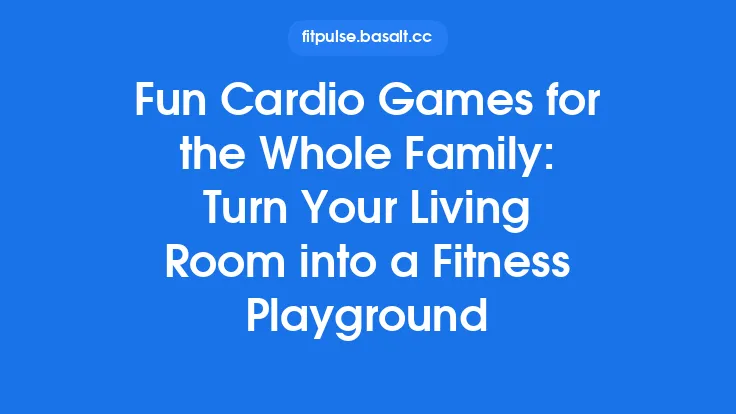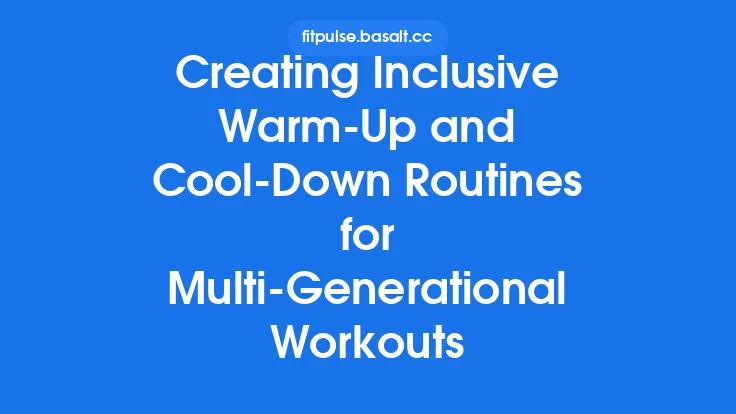Inclusive group fitness classes thrive when every participant feels seen, challenged, and safe, regardless of where they fall on the spectrum of physical ability, experience, or confidence. The art of designing such sessions lies in balancing universal design principles with thoughtful, on‑the‑spot modifications that keep the energy high while honoring individual limits. Below is a comprehensive guide for fitness professionals who want to create truly inclusive group environments, grounded in exercise science and practical experience.
Understanding Ability Diversity
1. Physical Spectrum
Participants may range from sedentary beginners to seasoned athletes, and from those with high joint mobility to individuals who move more cautiously due to past injuries or natural anatomical differences. Recognizing that “ability” is multidimensional—encompassing strength, endurance, flexibility, balance, and coordination—helps you anticipate the range of movement capacities in any class.
2. Sensory and Cognitive Variability
Some members rely heavily on visual cues, while others respond better to auditory or kinesthetic prompts. Cognitive processing speed can also differ, influencing how quickly participants can follow complex sequences. Tailoring cueing strategies ensures that everyone can decode the workout flow without feeling left behind.
3. Psychological Factors
Self‑efficacy, fear of judgment, and prior experiences with exercise shape how participants engage. An inclusive environment reduces anxiety by normalizing modifications and celebrating effort over perfection.
Core Principles of Inclusive Design
| Principle | Practical Translation |
|---|---|
| Universal Design | Structure the class so the default routine works for the majority, with built‑in options that anyone can adopt without feeling singled out. |
| Progressive Overload for All | Offer multiple pathways to increase intensity (e.g., weight, speed, range of motion) so each participant can progress on their own terms. |
| Scalability | Design each movement with at least three levels: beginner (low impact, limited range), intermediate (standard), and advanced (expanded range or added load). |
| Redundancy of Cues | Combine visual demonstrations, verbal explanations, and tactile prompts (e.g., hand‑on‑shoulder) to accommodate different learning styles. |
| Safety First | Prioritize joint alignment, core engagement, and breathing patterns in every modification to protect against injury. |
Assessing the Group Baseline
Before the first session, gather quick, non‑intrusive data:
- Pre‑Class Survey – Ask about recent activity levels, any current aches, preferred intensity, and comfort with equipment.
- Movement Screening – Perform a brief 5‑minute functional screen (e.g., squat depth, overhead reach, single‑leg balance) to spot common limitations.
- Observation – During the warm‑up, note who naturally adopts a higher or lower intensity and who needs extra cueing.
Use this information to set the “baseline” version of each exercise, then layer modifications on top.
Modifying Intensity and Volume
| Variable | Standard Option | Beginner Modification | Advanced Modification |
|---|---|---|---|
| Load | Bodyweight or light dumbbells (5–8 kg) | Reduce to bodyweight or use resistance bands with low tension | Increase weight (10–12 kg) or add a second set of dumbbells |
| Tempo | 2‑0‑2 (eccentric‑pause‑concentric) | Slow down eccentric phase (3‑0‑2) to reduce joint stress | Add explosive concentric (2‑0‑1) for power |
| Reps/Time | 12–15 reps or 45 s work | Decrease to 8–10 reps or 30 s work | Increase to 18–20 reps or 60 s work |
| Rest | 30 s between sets | Extend to 45–60 s | Shorten to 15–20 s for conditioning |
By adjusting these variables, you can keep the perceived effort (RPE) within a target range (e.g., 4–6 on a 0–10 scale) for all participants.
Adapting Movement Patterns
1. Range of Motion (ROM) Adjustments
- Reduced ROM: For a squat, allow participants to stop at a “chair” position (≈90° knee flexion) rather than a full depth.
- Extended ROM: Offer a “deep squat” cue for those comfortable, emphasizing hip hinge before knee bend.
2. Joint Load Management
- Replace high‑impact jumps with low‑impact step‑ups or lateral shuffles.
- Swap overhead presses for a “push‑through” chest press using a floor or bench to limit shoulder strain.
3. Balance Support
- Provide a sturdy surface (e.g., a wall or sturdy chair) for single‑leg exercises.
- Offer a “half‑step” version of lunges where the back foot stays on the ground for added stability.
4. Coordination Simplification
- Break complex combos (e.g., squat‑to‑press‑to‑lunge) into discrete stations, allowing participants to master each component before linking them.
Sensory and Cognitive Considerations
- Visual Aids: Use high‑contrast floor markings or colored cones to delineate movement zones.
- Auditory Cues: Pair verbal counts with rhythmic music cues (e.g., “2, 4, 6, 8” on the beat).
- Kinesthetic Prompts: Lightly guide a participant’s hand or hip to demonstrate proper alignment, always asking permission first.
- Chunking: Present instructions in short, logical chunks (“Step 1: Feet hip‑width. Step 2: Engage core. Step 3: Push through heels”).
- Repetition: Reinforce key cues throughout the class to aid memory retention.
Equipment and Environment Adjustments
| Element | Inclusive Option |
|---|---|
| Flooring | Use non‑slip, shock‑absorbing surfaces; provide yoga mats for those who need extra cushioning. |
| Weights | Offer a range of dumbbells (2–12 kg), kettlebells, and resistance bands of varying tension. |
| Props | Include chairs, low benches, stability balls, and foam rollers for alternative movement pathways. |
| Space Layout | Keep clear aisles for wheelchair or mobility‑aid users; arrange equipment in a circular or “hub‑and‑spoke” format to promote visibility. |
| Lighting & Sound | Ensure adequate lighting without glare; keep music volume at a level that allows clear instructor communication. |
Communication Strategies
- Inclusive Language – Use “we” statements (“Let’s find a version that works for you”) rather than “you” directives that may single out individuals.
- Positive Reinforcement – Highlight effort (“Great control on that modified squat”) instead of comparing to a perceived “ideal.”
- Open Invitation for Modifications – At the start, say, “If any movement feels too easy or too challenging, feel free to adjust—there’s a spot for every level.”
- Feedback Loop – Periodically ask, “How’s the intensity for you?” and adjust on the fly.
Progression and Monitoring
- Objective Metrics: Track repetitions, weight used, or time under tension for each participant.
- Subjective Metrics: Record RPE after each block; a consistent RPE of 4–5 suggests appropriate load, while 7+ may signal the need to scale back.
- Progression Pathways: Offer a “progression checklist” that includes options such as adding a weight, increasing ROM, or shortening rest. Participants can self‑select the next step when ready.
- Re‑Assessment: Conduct a brief functional screen every 4–6 weeks to gauge improvements and adjust class design accordingly.
Creating an Inclusive Culture
- Model Modifications: Demonstrate both the standard and at least one alternative version of each exercise.
- Peer Support: Encourage participants to share tips (“I found that placing a towel under my heel helps my squat depth”).
- Celebrate Diversity: Highlight stories of varied fitness journeys in newsletters or class announcements.
- Continuous Education: Stay updated on inclusive training certifications and attend workshops on adaptive cueing and equipment use.
Sample Inclusive Class Blueprint (45 minutes)
| Segment | Time | Core Exercise | Modification Options |
|---|---|---|---|
| Warm‑up | 5 min | Dynamic marching with arm circles | Low‑impact step‑touch for those needing reduced impact |
| Cardio Block | 10 min | Low‑impact circuit (step‑ups, side‑to‑side shuffles, seated punches) | - Step‑up height adjustable <br> - Seated version for limited standing tolerance |
| Strength Block | 15 min | Squat‑to‑press (dumbbell) | - Chair‑assisted squat <br> - Resistance band press only <br> - Full depth squat with heavier dumbbells |
| Core & Balance | 8 min | Plank variations | - Wall‑supported plank <br> - Standard forearm plank <br> - Elevated plank on bench |
| Cool‑down | 5 min | Stretch series (hamstring, chest, hip flexor) | - Seated stretch alternatives <br> - Use of strap for deeper stretch |
| Closing | 2 min | Group reflection & feedback | Open floor for participants to share what worked |
Final Thoughts
Inclusive group fitness is not a one‑size‑fits‑all checklist; it is a dynamic, responsive practice that blends solid exercise science with empathy and creativity. By systematically assessing ability diversity, embedding scalable modifications, and fostering a culture of respect, you empower every participant to move, improve, and belong. The result is a vibrant class where progress is measured not by uniformity, but by the collective celebration of individual journeys.





